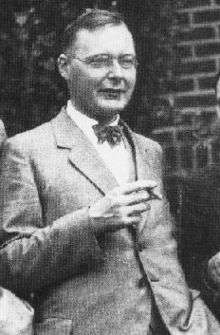Hans Kramers
| Hans Kramers | |
|---|---|
 Hans Kramers in c. 1928 | |
| Born |
Hendrik Anthony Kramers 2 February 1894 Rotterdam, Netherlands |
| Died |
24 April 1952 (aged 58) Oegstgeest, Netherlands |
| Nationality | Dutch |
| Fields | Physics |
| Alma mater | Leiden University |
| Doctoral advisor |
Niels Bohr Paul Ehrenfest |
| Doctoral students |
Henri Brinkman Dirk ter Haar Lamek Hulthén Nico van Kampen Jacob Kistemaker Tjalling Koopmans Luitzen Johannes Oosterhoff |
| Known for |
Kramers–Heisenberg formula Wentzel–Kramers–Brillouin approximation Kramers–Kronig relations Kramers–Wannier duality Kramers model for polymer chains Kramers–Anderson superexchange Kramers' degeneracy theorem Kramers' law Kramers' opacity law |
| Notable awards |
Lorentz Medal (1947) Hughes Medal (1951) |
Hendrik Anthony "Hans" Kramers (2 February 1894 – 24 April 1952) was a Dutch physicist who worked with Niels Bohr to understand how electromagnetic waves interact with matter.
Background and education
Hans Kramers was born in Rotterdam.[1] the son of Hendrik Kramers, a physician, and Jeanne Susanne Breukelman.
In 1912 Hans finished secondary education (HBS) in Rotterdam, and studied mathematics and physics at the University of Leiden, where he obtained a master's degree in 1916. Kramers wanted to obtain foreign experience during his doctoral research, but his first choice of supervisor, Max Born in Göttingen, was not reachable because of the first world war. Because Denmark was neutral in this war, as was the Netherlands, he travelled (by ship, overland was impossible) to Copenhagen, where he visited unannounced the then still relatively unknown Niels Bohr. Bohr took him on as a Ph.D. candidate and Kramers prepared his dissertation under Bohr's direction. Although Kramers did most of his doctoral research (on intensities of atomic transitions) in Copenhagen, he obtained his formal Ph.D. under Ehrenfest in Leiden, on 8 May 1919.
Kramers greatly enjoyed music and could play the cello and the piano.
Academic career
After working for almost ten years in Bohr's group and becoming an associate professor at the University of Copenhagen, Kramers left Denmark in 1926 and returned to the Netherlands. He became a full professor in theoretical physics at Utrecht University, where he supervised Tjalling Koopmans. In 1934 he left Utrecht and succeeded Paul Ehrenfest in Leiden. From 1931 until his death he held also a cross appointment at Delft University of Technology.
Kramers was one of the founders of the Mathematisch Centrum in Amsterdam.
In 1925, with Werner Heisenberg he developed the Kramers–Heisenberg dispersion formula. He is also credited[2] with introducing in 1948[3] the concept of renormalization into quantum field theory, although his approach was nonrelativistic.[2]
Family
On 25 October 1920 he was married to Anna Petersen. They had three daughters and one son.
Recognition
Kramers became member of the Royal Netherlands Academy of Arts and Sciences in 1929, he was forced to resign in 1942. He joined the Academy again in 1945.[4] Kramers won the Lorentz Medal in 1947 and Hughes Medal in 1951.
Notes
- ↑ BIOGRAPHICAL INDEX OF FORMER FELLOWS OF THE ROYAL SOCIETY OF EDINBURGH 1783 – 2002 (PDF). The Royal Society of Edinburgh. July 2006. ISBN 0 902 198 84 X.
- 1 2 Jagdish Mehra, Helmut Rechenberg, The Conceptual Completion and Extensions of Quantum Mechanics 1932-1941. Epilogue: Aspects of the Further Development of Quantum Theory 1942-1999: Volumes 6, Part 2, Springer, 2001, p. 1050.
- ↑ Kramers presented his work at the Shelter Island Conference, repeated in 1948 at the Solvay Conference. The latter did not appear in print until the Proceedings of the Solvay Conference, published in 1950 (see Laurie M. Brown (ed.), Renormalization: From Lorentz to Landau (and Beyond), Springer, 2012, p. 53).
- ↑ "Hans A. Kramers (1894 - 1952)". Royal Netherlands Academy of Arts and Sciences. Retrieved 28 July 2015.
References
- Dresden, Max (1987). H.A. Kramers – Between Tradition and Revolution. Springer. ISBN 0-387-96282-4.
- Belinfante, F. J.; ter Haar, D. (1952). "Hendrik Anthony Kramers: 1894–1952". Science. 116 (3021): 555–556. Bibcode:1952Sci...116..555B. doi:10.1126/science.116.3021.555.
External links
| Wikimedia Commons has media related to Hendrik Anthony Kramers. |
- H.B.G. Casimir, Kramers, Hendrik Anthony (1894–1952), in Biografisch Woordenboek van Nederland. (in Dutch)
- J.M. Romein, Hendrik Anthony Kramers, in: Jaarboek van de Maatschappij der Nederlandse Letterkunde te Leiden, 1951–1953, pp. 83–91. (in Dutch)
- Ph.D. candidates of H.A. Kramers: 1929-1952
- Publications of H.A. Kramers